Melasma (a term derived from Greek word ‘melas’ meaning black) is an acquired blotchy, irregularly patterned, brown or sometimes grey-brown melanosis of the face and occasionally the neck, of poorly understood etiology but attributable to sunlight and genetic predisposition.
It is also known as chloasma and used for a pattern of asymptomatic superficial brownish pigmentation seen mainly in females.
The lesions are usually seen on the bridge of the nose, cheeks, upper lip and forehead. On the forehead, a linear area just above the eyebrows is common. The lesions are usually bilateral and often symmetrical.
They become more prominent after sun exposure. Usually the lesions appear during pregnancy but have also been seen in unmarried girls and males, females who have disturbed menstrual cycle, have been taking contraceptive pills since long are at increased risk of developing melasma.
Cause of Melasma
- Estrogen is the most important factor. This explains the prevalence of the disease in pregnancy and after use of oral contraceptives.
- Sun exposure: UVB light is an important cause
- Iron folate deficiency
- Cosmetics, fragrances
- Genetic factors
- Racial factors
Melasma can be either diffuse or may be mottled. It may be either totally epidermal (as in early cases) or mixed (as in later cases, when part of the pigment descends in to dermis.)
Cause and Manifestations of melasma
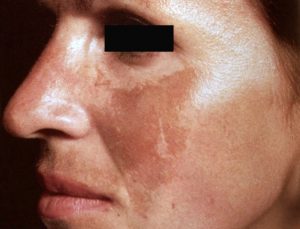
Melasma is most frequently noticed on sun-exposed areas of the face, especially the cheeks, forehead, upper lip, nose, and chin. Scars and moles located inside a melasma patch may also undergo progressive darkening. Patches may appear in a symmetric pattern.
The three classic distributions for facial Chloasma hyper pigmentation are (a) malar, involving the cheeks; (b) centrofacial, involving the forehead, cheeks, chin and upper lip; and (c) mandibular, classically involving the chin and jaw line. Chloasma is not limited to the face, and is often seen in the dorsal extremities and sun-exposed areas.
Melasma is caused by proliferation of melanocytes and increased production of melanosomes. The tendency to suffer from Chloasma is inherited. Some females begin to experience the condition as a result of puberty-induced hormonal rises. In others, the hormonal changes of pregnancy are the probable cause.
Melanocyte possesses estrogen receptors that stimulate hyperactivity. Both estrogen and progesterone stimulate melanogenasis through this mechanism, and both are elevated during pregnancy. Ingestion of oral contraceptive pills and estrogen supplements produces melasma through the same mechanism.
Melasma is exacerbated by sun exposure, which accounts for its heightened incidence in those who receive greater amounts of UVB radiation. The etiology in males is less well understood, but is not thought to be related to hormonal causes; it may be testicular resistance.
Homeopathic treatment of Melasma
Homeopathy is one of the most popular holistic systems of medicine. The selection of remedy is based upon the theory of individualization and symptoms similarity by using holistic approach. This is the only way through which a state of complete health can be regained by removing all the sign and symptoms from which the patient is suffering.
The aim of homeopathy is not only to treat melasma but to address its underlying cause and individual susceptibility. As far as therapeutic medication is concerned, several remedies are available to treat melasma that can be selected on the basis of cause, sensations and modalities of the complaints.
For individualized remedy selection and treatment, the patient should consult a qualified homeopathic doctor in person. There are following homeopathic remedies which are helpful in the treatment of melasma:
Sepia Succus
Conium Maculatum
Pulsatilla Nigricans
Cadmium Sulphuratum
Caulophyllum Thalictroides
Elemuy Gauteria
Ferrum Metallicum
Lycopodium Clavatum
Nitricum Acidum
Strychnos Nux-vomica
Paullinia Sorbilis
Paullinia Pinnata
Pitutaria Glandula Posterior
Thuja Occidentalis

Lycopodium – grayish yellow color of face, with blue circles around eyes; withered, shriveled, and emaciated; copper colored eruptions; itching liver spots; yellow grey complexion; brown spots on the face and nose. Dark discolouration on cheeks in males. Especially suits men who are mild when in society but domineering on loved ones at home. Perspiration is profuse and often yellow staining. Gastric disturbances accompany.
Nitric acid – scaly skin of face; black pores on face; freckles of face. Hyperpigmentation with anemia. Violent anger. Warts which are jagged and bleed easily.
Phosphorous – brownish spots here and there all over body; pale sickly complexion, blue rings around the eyes; circumscribed redness in one or both cheeks. Females with fair complexion, exposure to sun aggravates, friendly and social disposition; crave cold drinks, ice creams, fruits and chocolate.
Argentum nitricum – skin is brown; old, pale, bluish, and sunken look of face; old man’s appearance. Especially suits men who are anxious and fastidious about appearance in nature; anxiety if time is set for a meeting or engagement; desire for sweets, warmth agg.
Thuja – eruptions on face, leaving bluish appearance; light brown spots on face; the skin is oily. Blackish discolouration on forehead and temples with slightly raised skin in men; effects of chronic sun exposure. Tendency for warts and asthma.
Sulphur – dry, rough skin, old looking people; pale, sickly color; liver spots; burning with spotting redness of face. Skin appears dirty and uneven. Warmth aggravates. Craves sweets. History of suppressed skin eruptions.

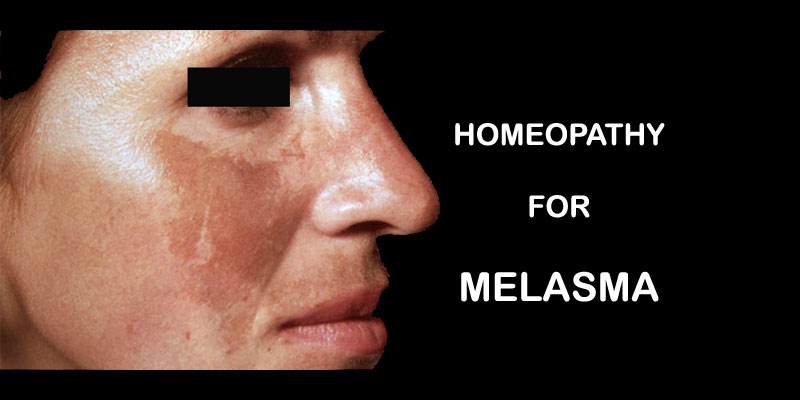
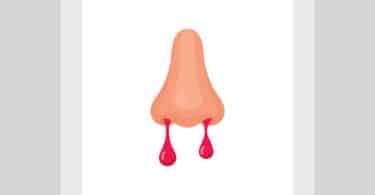
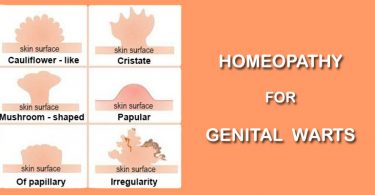
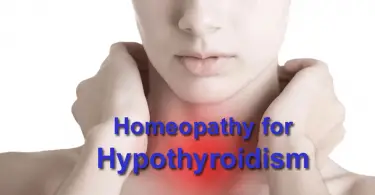

I am 20 years old boy . On my either sides of nose a light black dark irregular spot is formed and my left cheek there are some spots present.I have acne problems as my skin is oily. In my nose and left cheek some blackheads are present .lt is not gone from my skin after using some ayurvedic homeremedies . So I need help to remove it from my face through homeopathy pathy permanently.
I am 40 years old. Pigmentation on the side locks. Please suggest the medicine
And acne on jawline also.Dark sports after acne..
Please help
take sepia 30, tellurium 30,bacillinum 30,all tds & thuja 10m every 15th day 4 doses.then call me 9621281183
Dr. Gupta, we can’t do “one-size-fits-all” in homeopathy. And you’re not monitoring the dosing, you’re just saying “Do it.” In The Organon, Hahnemann says that a striking improvement precludes all further dosing for as long as the improvement lasts. And he says that an aggravation precludes all further dosing. But you’re not monitoring this protocol, you’re not going to know if any of this occurs. You’re putting at risk anybody who takes you up on this advice.